Summary Statement
This guidance from the British Health and Safety Executive was designed for employers to safely use ladders and stepladders, but should also be useful for employees and their representatives. The HSE indicates that ladders can be a sensible and practical option for low-risk, short-duration tasks, although they shouldn't automatically be the first choice.
The guide recommends that if your task requires staying on a leaning ladder or stepladder for more than 30 minutes at a time, you should consider alternative equipment. The guidance contains excellent and clear graphics to demonstrate proper ladder use that will work well in training programs.
January 2014
Ladders and stepladders are not banned under health and safety law.
In fact they can be a sensible and practical option for low-risk, short-duration tasks.
Introduction
 This guidance is for employers on the simple, sensible precautions they should take to keep people safe when using ladders and stepladders in the workplace. This will also be useful for employees and their representatives.
This guidance is for employers on the simple, sensible precautions they should take to keep people safe when using ladders and stepladders in the workplace. This will also be useful for employees and their representatives.
Following this guidance is normally enough to comply with the Work at Height Regulations 2005 (WAHR). You are free to take other action, except where the guidance says you must do something specific.
Ladders and stepladders are not banned under health and safety law.
In fact they can be a sensible and practical option for low-risk, short-duration tasks, although they may not automatically be your first choice. Make sure you use the right type of ladder and you know how to use it safely.
The law calls for a sensible, proportionate approach to managing risk, and further guidance on what you should do before deciding if a ladder is the right type of equipment for a particular task is provided in Working at height: A brief guide (see ‘Further reading’).
References to ladders in this leaflet, unless otherwise indicated, refer to leaning ladders (sometimes known as extension ladders) and stepladders and the guidance applies similarly to both. More specific requirements that only apply to a leaning ladder or a stepladder are covered in detail under the relevant headings.
When is a ladder the most suitable equipment?
The law says that ladders can be used for work at height when a risk assessment has shown that using equipment offering a higher level of fall protection is not justified because of the low risk and short duration of use; or there are existing workplace features which cannot be altered.
Short duration is not the deciding factor in establishing whether use of a ladder is acceptable or not – you should have first considered the risk. As a guide, if your task would require staying up a leaning ladder or stepladder for more than 30 minutes at a time, it is recommended that you consider alternative equipment.
You should only use ladders in situations where they can be used safely, eg where the ladder will be level and stable, and where it is reasonably practicable to do so, the ladder can be secured.
Who can use a ladder at work?
To use a ladder you need to be competent, ie have had instruction and understand how to use the equipment safely.
Appropriate training can help. If you are being trained, you should work under the supervision of somebody who can perform the task competently. Training can often take place on the job.
Check your ladder before you use it
Before starting a task, you should always carry out a ‘pre-use’ check to spot any obvious visual defects to make sure the ladder is safe to use.
A pre-use check should be carried out:
- by the user;
- at the beginning of the working day;
- after something has changed, eg a ladder has been dropped or moved from a dirty area to a clean area (check the state or condition of the feet).
Check the stiles – make sure they are not bent or damaged, as the ladder could buckle or collapse.
Check the feet – if they are missing, worn or damaged the ladder could slip. Also check ladder feet when moving from soft/dirty ground (eg dug soil, loose sand/stone, a dirty workshop) to a smooth, solid surface (eg paving slabs), to make sure the foot material and not the dirt (eg soil, chippings or embedded stones) is making contact with the ground.
Check the rungs – if they are bent, worn, missing or loose the ladder could fail.
Check any locking mechanisms – if they are bent or the fixings are worn or damaged the ladder could collapse. Ensure any locking bars are engaged.
Check the stepladder platform – if it is split or buckled the ladder could become unstable or collapse.
Check the steps or treads on stepladders – if they are contaminated they could be slippery; if the fixings are loose on steps, they could collapse.
If you spot any of the above defects, don’t use the ladder and notify your employer.
Use your ladder safely
Once you have done your ‘pre-use’ check, there are simple precautions that can minimise the risk of a fall.
Leaning ladders
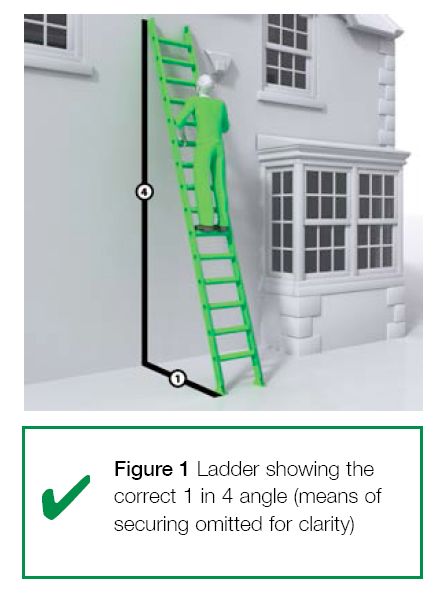 When using a leaning ladder to carry out a task:
When using a leaning ladder to carry out a task:
- only carry light materials and tools – read the manufacturers’ labels on the ladder and assess the risks;
- don’t overreach – make sure your belt buckle (navel) stays within the stiles;
- make sure it is long enough or high enough for the task;
- don’t overload it – consider workers’ weight and the equipment or materials they are carrying before working at height. Check the pictogram or label on the ladder for information;
- make sure the ladder angle is at 75° – you should use the 1 in 4 rule (ie 1 unit out for every 4 units up) – see Figure 1;
- always grip the ladder and face the ladder rungs while climbing or descending – don’t slide down the stiles;
- don’t try to move or extend ladders while standing on the rungs;
-
 don’t work off the top three rungs, and try to make sure the ladder extends at least 1 m (three rungs) above where you are working;
don’t work off the top three rungs, and try to make sure the ladder extends at least 1 m (three rungs) above where you are working; - don’t stand ladders on moveable objects, such as pallets, bricks, lift trucks, tower scaffolds, excavator buckets, vans, or mobile elevating work platforms;
- avoid holding items when climbing (consider using a tool belt);
- don’t work within 6 m horizontally of any overhead power line, unless it has been made dead or it is protected with insulation. Use a non-conductive ladder (eg fibreglass or timber) for any electrical work;
- maintain three points of contact when climbing (this means a hand and two feet) and wherever possible at the work position – see Figures 2 and 3;
- where you cannot maintain a handhold, other than for a brief period (eg to hold a nail while
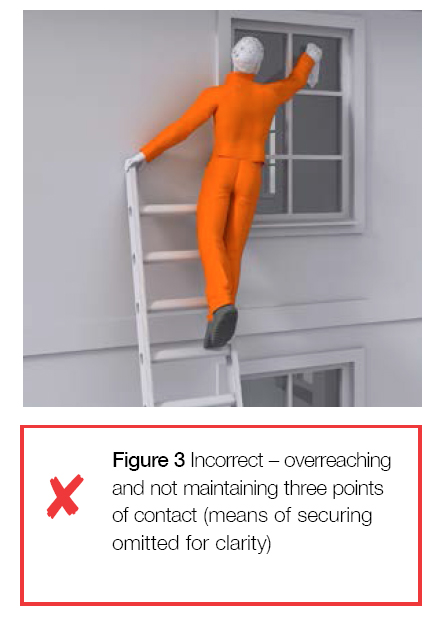 starting to knock it in, starting a screw etc), you will need to take other measures to prevent a fall or reduce the consequences if one happened;
starting to knock it in, starting a screw etc), you will need to take other measures to prevent a fall or reduce the consequences if one happened; - for a leaning ladder, you should secure it (eg by tying the ladder to prevent it from slipping either outwards or sideways) and have a strong upper resting point, ie do not rest a ladder against weak upper surfaces (eg glazing or plastic gutters – see Figure 4);
- you could also use an effective stability device.
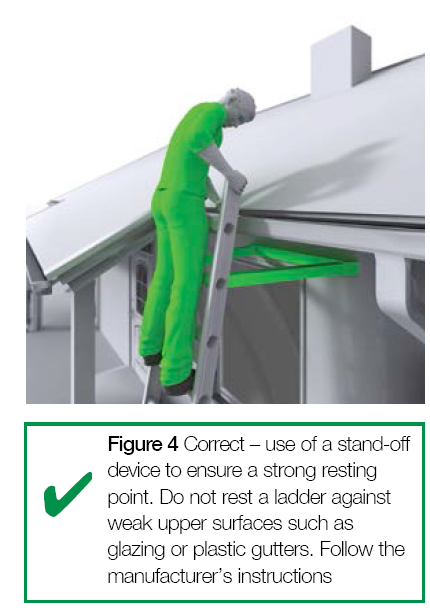
Stepladders
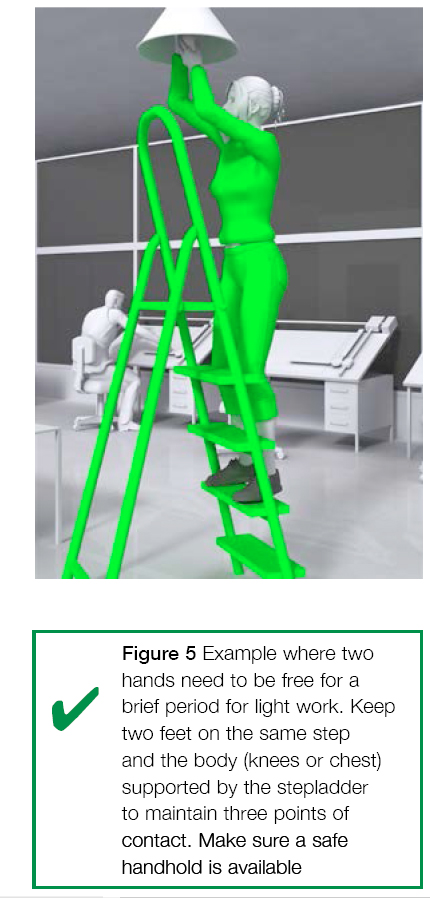 When using a stepladder to carry out a task:
When using a stepladder to carry out a task:
- check all four stepladder feet are in contact with the ground and the steps are level;
- only carry light materials and tools;
- don’t overreach;
- don’t stand and work on the top three steps (including a step forming the very top of the stepladder) unless there is a suitable handhold;
- ensure any locking devices are engaged;
- try to position the stepladder to face the work activity and not side on. However, there are occasions when a risk assessment may show it is safer to work side on, eg in a retail stock room when you can’t engage the stepladder locks to work face on because of space restraints in narrow aisles, but you can fully lock it to work side on;
- try to avoid work that imposes a side loading, such as side-on drilling through solid materials (eg bricks or concrete);
- where side-on loadings cannot be avoided, you should prevent the steps from tipping over, eg by tying the steps. Otherwise, use a more suitable type of access equipment;
- maintain three points of contact at the working position. This means two feet and one hand, or when both hands need to be free for a brief period, two feet and the body supported by the stepladder (see Figure 5 and associated text).
When deciding if it is safe to carry out a particular task on a stepladder where you cannot maintain a handhold (eg to put a box on a shelf, hang wallpaper, install a smoke detector on a ceiling), this needs to be justified, taking into account:
- the height of the task;
- whether a handhold is still available to steady yourself before and after the task;
- whether it is light work;
- whether it avoids side loading;
- whether it avoids overreaching;
- whether the stepladder can be tied (eg when side-on working).
What about the place of work where the ladder will be used?
As a guide, only use a ladder:
- on firm ground;
- on level ground – refer to the manufacturer’s pictograms on the side of the ladder. Use proprietary levelling devices, not ad-hoc packing such as bricks, blocks, timbers etc;
- on clean, solid surfaces (paving slabs, floors etc). These need to be clean (no oil, moss or leaf litter) and free of loose material (sand, packaging materials etc) so the feet can grip. Shiny floor surfaces can be slippery even without contamination;
- where they will not be struck by vehicles (protect the area using suitable barriers or cones);
- where they will not be pushed over by other hazards such as doors or windows, ie secure the doors (not fire exits) and windows where possible;
- where the general public are prevented from using it, walking underneath it or being at risk because they are too near (use barriers, cones or, as a last resort, a person standing guard at the base);
- where it has been secured.
What are the options for securing ladders?
 The options are as follows:
The options are as follows:
- tie the ladder to a suitable point, making sure both stiles are tied, see Figures 6, 7 and 8;
- where this is not practical, secure with an effective ladder stability device;
- if this is not possible, then securely wedge the ladder, eg wedge the stiles against a wall;
- if you can’t achieve any of these options, foot the ladder. Footing is the last resort. Avoid it, where ‘reasonably practicable’, by using other access equipment.
What about ladders used for access?
In general:
- ladders used to access another level should be tied (see Figure 9) and extend at least 1 m
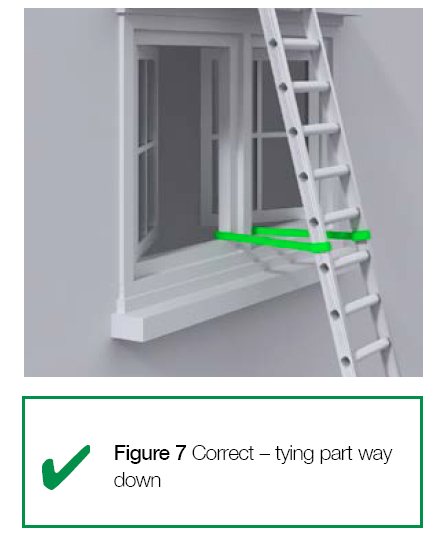 above the landing point to provide a secure handhold. At ladder access points, a self-closing gate is recommended;
above the landing point to provide a secure handhold. At ladder access points, a self-closing gate is recommended; - stepladders should not be used to access another level, unless they have been specifically designed for this.
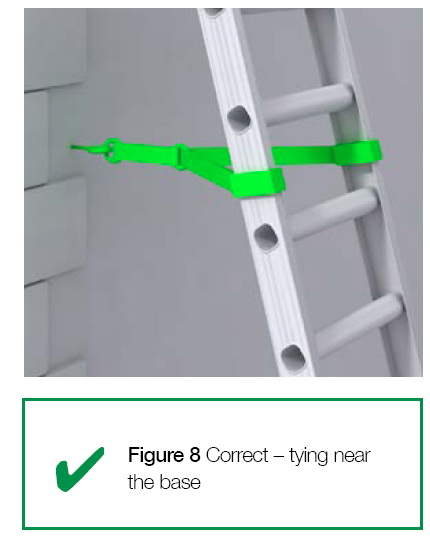
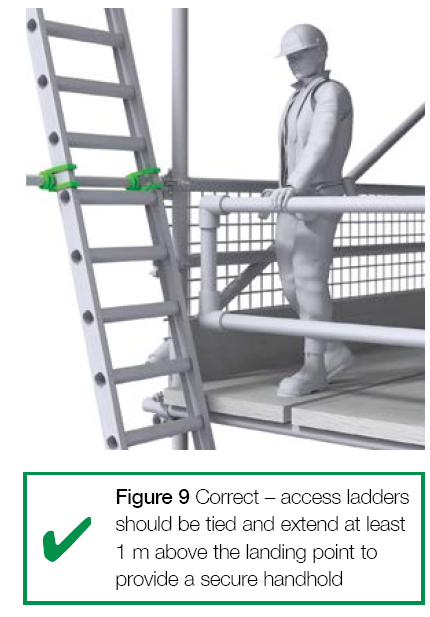
What about the condition of the equipment?
Employers need to make sure that any ladder or stepladder is both suitable for the work task and in a safe condition before use. As a guide, only use ladders or stepladders that:
- have no visible defects. They should have a pre-use check each working day;
- have an up-to-date record of the detailed visual inspections carried out regularly by a competent person. These should be done in accordance with the manufacturer’s instructions. Ladders that are part of a scaffold system still have to be inspected every seven days as part of the scaffold inspection requirements;
- are suitable for the intended use, ie are strong and robust enough for the job. HSE recommends British Standard (BS) Class 1 ‘Industrial’ or BS EN 131 ladders for use at work (see ‘Further reading’);
- have been maintained and stored in accordance with the manufacturer’s instructions.
A detailed visual inspection is similar to ‘pre-use’ checks’, in that it is used to spot defects. It can be done in-house by a competent person (pre-use checks should be part of a user’s training) and detailed visual inspections should be recorded.
When doing an inspection, look for:
- twisted, bent or dented stiles;
- cracked, worn, bent or loose rungs;
- missing or damaged tie rods;
- cracked or damaged welded joints, loose rivets or damaged stays.
Make pre-use checks and inspect ladder stability devices and other accessories in accordance with the manufacturer’s instructions.
Further reading
Working at height safely: A brief guide Leaflet INDG401(rev2) HSE Books 2014 www.hse.gov.uk/pubns/indg401.htm
Work at height web pages on the HSE website: www.hse.gov.uk/work-at-height/index.htm
You can access the Work at height Access equipment Information Toolkit (WAIT) at www.hse.gov.uk/work-at-height/wait/index.htm
British Standards provide more information on current product standards (see ‘Further information’), eg:
- BS 1129 Specification for portable timber ladders, steps, trestles and lightweight stagings British Standards Institution
- BS 2037 Specification for portable aluminium ladders, steps, trestles and lightweight stagings British Standards Institution
- BS EN 131 Ladders (Specification for terms, types, functional sizes; Specification for requirements, testing, marking; User instructions; Single or multiple hinge-joint ladders) British Standards Institution
Further information
For information about health and safety, or to report inconsistencies or inaccuracies in this guidance, visit www.hse.gov.uk. You can view HSE guidance online and order priced publications from the website. HSE priced publications are also available from bookshops.
British Standards can be obtained in PDF or hard copy formats from BSI: http://shop.bsigroup.com or by contacting BSI Customer Services for hard copies only Tel: 0845 086 9001 email: cservices@bsigroup.com.
This guidance is issued by the Health and Safety Executive. Following the guidance is not compulsory, unless specifically stated, and you are free to take other action. But if you do follow the guidance you will normally be doing enough to comply with the law. Health and safety inspectors seek to secure compliance with the law and may refer to this guidance.
This leaflet is available at www.hse.gov.uk/pubns/indg455.htm.
© Crown copyright If you wish to reuse this information visit www.hse.gov.uk/copyright.htm for details. First published 01/14.


